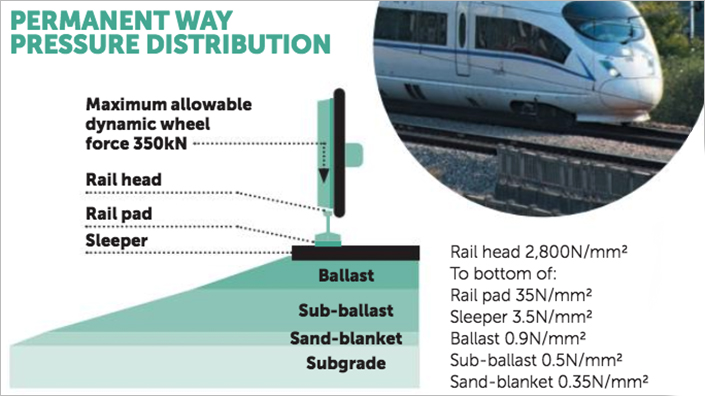Articles
Yet such features rarely have any serious engineering analysis. In 2012, Elon Musk’s paper proposed his Hyperloop concept of pods in vacuum tubes. In this, he recorded his disappointment that the home of Silicon Valley is building a high-speed railway that he, and others, see as an outdated technology.
Although railways have a long history, this is no bad thing. They now benefit from many years of experience. Since the late 18th century, railway track, known as the permanent way, has been the subject of worldwide R&D, which now enables it to absorb high dynamic loads and sustain demanding tolerances to carry high-speed trains at up to 360km/h or freight trains of thousands of tonnes. Similarly, rolling-stock suspensions, wheelsets and wheel profiles have been developed to enable such trains to run smoothly and safely. The result is an engineering system that provides the most efficient way of carrying large numbers of passengers or freight because:
Taking the load
Loads are efficiently distributed – as shown in the diagram, the maximum dynamic wheel force of 350kN results in a pressure on the rail head of 2.8kN/mm2 which is progressively reduced through the rails, sleepers and ballast to 0.5N/mm2. Hence, on a relatively narrow formation, railways can carry particularly heavy loads.
Low resistance to motion – the rolling resistance of steel wheels on steel rails is about 0.1% of the weight of the train compared with 1% for car tyres on a road. At speed, aerodynamic resistance becomes the dominant factor. In this respect close-coupled railway vehicles have lower drag than the same number of individual vehicles.

Mass movement
High capacity – the ability to couple many vehicles together offers high freight and passenger capacity. A Eurostar train can carry 900 passengers. When completed, HS2 will have capacity for 18 such trains an hour out of London, about 16,000 passengers an hour. A two-lane motorway carries around 4,000 people an hour.
Collecting electricity on the move – as trains are part of a guided system it is possible to provide them with a fixed-current collection system that can receive megawatts of power as it is generated. So electric trains are highly efficient.
Connectivity – new railways connect into the existing network to offer far more journey opportunities than just those on the new line.
So what of Hyperloop? Engineering analysis of the Hyperloop system shows that many significant problems have yet to be addressed, for example there is as yet no proof of concept for switching very high-speed pods between tubes. Even if it was possible to prove the safety integrity of all its aspects, the cost of hundreds of kilometres of vacuum tube infrastructure has to be justified. Yet with its small pods Hyperloop has poor passenger capacity, as shown in Musk’s paper which states that it would carry 840 passengers an hour.
Maglev too costly
Unlike Hyperloop, the technical feasibility of maglev has been demonstrated. Its electromagnetic levitation also eliminates a train’s rolling resistance, yet at high speeds this is a tiny fraction of the aerodynamic drag and is comparable with the energy required for levitation. With no wheels, maglevs offer maximum speeds of around 500km/h compared with 360km/h for high-speed rail. Between London and Manchester this offers a time saving of around 15 minutes. It is difficult to imagine how such small time savings could justify the huge cost of maglev infrastructure.
Those promoting Hyperloop and maglev have yet to demonstrate that they have addressed all safety, engineering, operational and economic aspects. It is unlikely that they ever will. Hence modern railways will continue to provide the most efficient way of transporting freight and large numbers of passengers.
Want the best engineering stories delivered straight to your inbox? The Professional Engineering newsletter gives you vital updates on the most cutting-edge engineering and exciting new job opportunities. To sign up, click here.
Content published by Professional Engineering does not necessarily represent the views of the Institution of Mechanical Engineers.